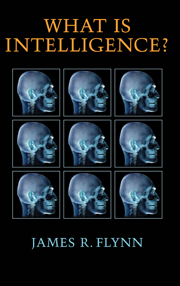Book contents
- Frontmatter
- Contents
- List of figures
- List of tables
- List of boxes
- Preface to the expanded paperback edition
- Acknowledgments
- 1 A bombshell in a letter box
- 2 Beyond the Flynn effect
- 3 Towards a new theory of intelligence
- 4 Testing the Dickens/Flynn model
- 5 Why did it take so long?
- 6 IQ gains can kill
- 7 What if the gains are over?
- 8 Knowing our ancestors
- 9 The art of writing cognitive history
- 10 About GUT: the grand unification theory of intelligence
- 11 Howard Gardner and the use of words
- Appendix I Tables
- Appendix II Declaration in a capital case
- References
- Subject index
- Name index
4 - Testing the Dickens/Flynn model
Published online by Cambridge University Press: 05 August 2012
- Frontmatter
- Contents
- List of figures
- List of tables
- List of boxes
- Preface to the expanded paperback edition
- Acknowledgments
- 1 A bombshell in a letter box
- 2 Beyond the Flynn effect
- 3 Towards a new theory of intelligence
- 4 Testing the Dickens/Flynn model
- 5 Why did it take so long?
- 6 IQ gains can kill
- 7 What if the gains are over?
- 8 Knowing our ancestors
- 9 The art of writing cognitive history
- 10 About GUT: the grand unification theory of intelligence
- 11 Howard Gardner and the use of words
- Appendix I Tables
- Appendix II Declaration in a capital case
- References
- Subject index
- Name index
Summary
It is the mark of an educated man … that in every subject he looks for only so much precision as its nature permits.
(Aristotle, Ethics, i, 3, 1094b, 24–26)Dickens and Flynn think that the Dickens/Flynn model is important. In Chapter 2, it was used to solve the paradox of how environment could appear so feeble in the twin studies and yet so potent in IQ gains over time. Therefore, it stands as a serious attempt to integrate the level of individual differences (twin studies) and the level of social trends (IQ gains over time). At present, there is no model that can claim to integrate the level of individual differences and the level of brain physiology. If we get one, there would be only one step left: the integration of those two models into what would truly be a BIDS theory of intelligence. The model is also important because it has implications for how IQ can be enhanced.
Interventions and raising IQ
Interventions that may enhance IQ include the efforts of parents; affording an enriched environment to children at risk; adoption; and university study. It is important that parents do their best by their children but they must reconcile themselves to the fact that their efforts cannot be decisive in the long term.
The Dickens/Flynn model posits a tug of war between two environments: the environment parents impose, which is not directly correlated with the child's unique genetic endowment; and the environment the child creates by interacting with the world, which does tend to match the child's unique genetic endowment.
- Type
- Chapter
- Information
- What Is Intelligence?Beyond the Flynn Effect, pp. 83 - 99Publisher: Cambridge University PressPrint publication year: 2007



